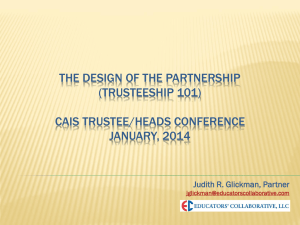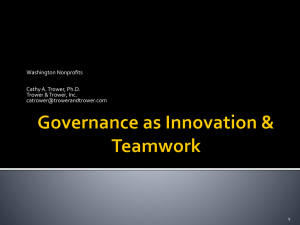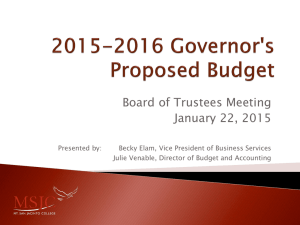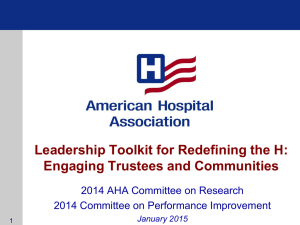Susan Daniel`s Presentation
advertisement
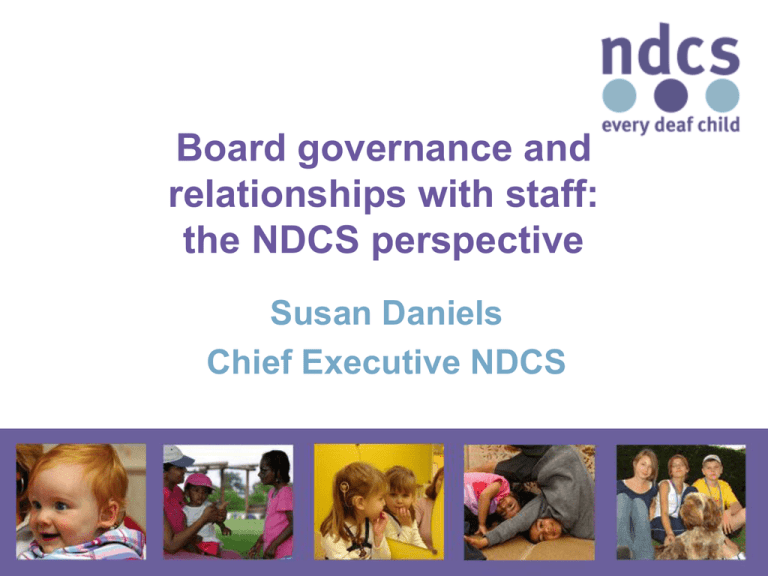
Board governance and relationships with staff: the NDCS perspective Susan Daniels Chief Executive NDCS Contents • NDCS – vision and strategy • Governance arrangements • The role of trustees • Conclusion Our vision... A world without barriers for every deaf child Our strategy We work with : • • • • • • • Children Families Professionals Communities Statutory bodies Other voluntary organisations Politicians and opinion formers Small beginnings • When did NDCS start? – 5pm,15 December 1944 – 14 parents of deaf children met at Mrs Mullins’ house in Berkley Court, London Growth – income • • • • • • 1945 - £97 3 years later… £648 19 years later…£26k 55 years later…£3.8m 59 years later…£11.5m In our 60th year…£10.4m • 68 years after we were founded…£21.m (budgeted) Growth : staff 1952 = 1 2012 = 204 Growth : members 2012 2006 2000 28,864 1988 1967 7,532 1945 1946 1949 125 245 589 4,500 9,357 13,672 Major Strategic Developments • 1993: Regional delivery commences • 2002 : International arm (Deaf Child Worldwide) which works in South Asia, East Africa and Latin America was formed • 2007 : Policy and campaign function established – national and regional campaigns teams • 2009 : Direct work with deaf children and young people commences Governance • NDCS is a registered charity in England, Wales and Scotland, and a limited company. • Our constitution (M&A) sets out our objects (what NDCS is set up to do), how we are governed and who our members are. • NDCS is governed by a Trustee Board of up to 12 Trustees, up to 8 of whom must be the parent of a deaf child and up to 4 more who bring additional skills required. Board meets four times each year. • Our SMT consists of the Chief Executive and 5 Executive Directors. Key developments in Board effectiveness • 2003 - maximum terms of 9 years for trustees • 2003 - governance framework – role description, policies, induction • 2008 - Board reduced from 19 to 12 trustees • 2008 - principle of competence (not representation) as the basis for trustee recruitment, with rigorous recruitment and selection process • 2008 - trustee appraisal and board development process introduced. Key outcomes • Parents of deaf children have remained at the heart of the governance of NDCS • The development of the board has mirrored the growth of NDCS • Recruitment, selection and board development processes has led to enhanced trustee effectiveness Trustees’ formal responsibilities • To set the strategy for NDCS • To monitor performance • To ensure NDCS is run effectively, to manage its assets prudently, to comply with relevant regulation. • To act always in the best interests of NDCS. So what do our Trustees actually do? • • • • See the big picture for NDCS and our users Give leadership Set priorities Scrutinise, monitor, challenge and hold the SMT to account • Comply with legislation and regulation • Serve as ambassadors and advocates What Trustees should not do • Manage the charity day to day • Make operational decisions (“cancel this event”) • Allow cliques to form on the Board • Champion particular services, user groups, or staff. • Bypass the CEO! The Board and the CEO • Trustees need to understand the CEO’s role (should be part of trustee induction) • Trustees should hold the CEO to account, but allow him/her to implement strategy and manage the charity • Trustees must recruit the CEO and must not delegate this • The Board’s primary staff relationship is with the CEO, and can take many styles……… Trustees and the CEO – how is it for you? High support Supporters club Partner or critical friend “We’re here to support the CE” “We share everything – good or bad.” Low challenge High challenge Abdicators Adversaries “We leave it to the professionals” “We keep a very close eye on the staff” Low support The Trustees’ relationship with senior staff: what makes it work • A strategic partnership – both contribute vision and expertise. • A clear understanding of both roles • Communication – regular, open and honest • Trust and mutual respect • Willingness to work hard at the relationship (keep talking) • No surprises – from either party! • Shared experience of good and bad times Conclusion • Trustees and CEO/SMT are a partnership • Understand your role and stick to it • The partnership between the Board Chair and the CEO is key Any questions?

